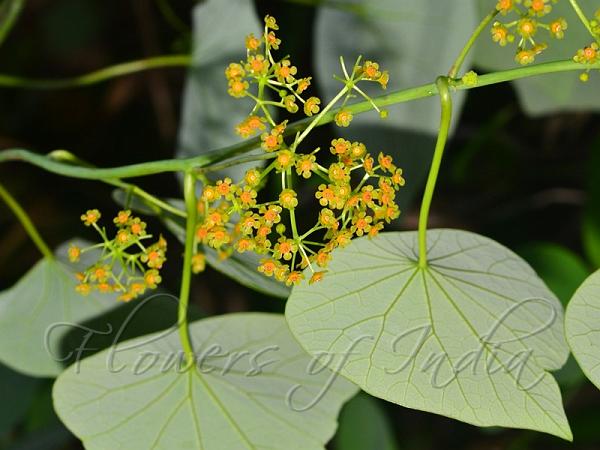|
| East-Himalayan Tape Vine |
|

|

| File size | 157450 |
| Original date | 5/2/18 6:22 AM |
| Resolution | 2448 x 3696 |
| Flash | Flash fired, return detected |
| Focal length | 60.0mm |
| Exposure time | 1/250s |
| Aperture | 9.0 |
| Focus Distance | |
| Metering Mode | Multi-segment |
| Camera make | NIKON CORPORATION |
| Camera model | NIKON D7000 |
| Sensor type | OneChipColorArea |
|
|
|
|
Photo: |
Botanical name: Stephania glandulifera Family: Menispermaceae (Moonseed family)
East-Himalayan Tape Vine is a large climbing shrubs or
woody vines. Flowers are borne in leaf-axils or at branch-ends, in
stalked umbel-like cymes. Flowers are unisexual, greenish yellow. Male
inflorescence is in leaf-axils umbel-like cymes. Male flowers, sepals
6-8, in series, ovate-obovate, tip blunt, glandular, papillose on
dorsal side, petals 3-4, thick, round, base wedge-shaped, tip blunt,
synandrium peltate, about 1 mm long. Female flowers greenish yellow,
narrow wedge-shaped, hairless, style short, stigma 5-fid or lobed.
Leaves are simple, nearly round, somewhat heart-shaped or triangular,
5-11 x 4-10 cm across, base somewhat heart-shaped or nearly flat,
margin entire, tip pointed or blunt with with a short sharp point tip,
papery, membranous, dark green, hairless above, paler glaucous beneath,
strong basal veins 5-7 towards the tip, 3-5 towards the base from the
leaf-stalk, impressed above and slightly prominent beneath. Leaf-stalk
is slender, thickened at the base, attached about 1-1.5 cm inside the
blade from the base, about 7-15 cm long. Fruits are drupes, nearly
spherical or obovoid, slightly compressed, about 7-10 x 5-7 mm across,
stalkless, red when mature. East-Himalayan Tape Vine is found in East
Himalaya, in Assam, Manipur, Meghalaya, Nagaland, Sikkim at altitudes
of 1300-2100 m, and also in Myanmar, Nepal, Thailand.
| Identification credit: M. Sawmliana, J.M. Garg | Photographed in Aizawl, Mizoram. |
• Is this flower misidentified? If yes,